After a tree is removed, the stump that is left behind can be an eyesore as well as a possible hazard. Stump grinding is the process of mechanically grinding a stump into small wood chips, removing the visible section of the stump. This not only improves the appearance of your outdoor space but also minimizes safety issues. In this guide we will tell you how long does it take to grind a stump and what is the process of stump grinding.
The Stump Grinding Process
Equipment Used
Stump grinders are heavy-duty equipment with a rotating carbide-tipped steel wheel on the front that resembles an enlarged circular saw blade.
This wheel is dropped onto the stump’s edge and moved from side to side, grinding further into the stump with each revolution. The whole tree stump, including the major roots below, is pulverized into little wood chips.
Depth of Grind
Depending on your requirements, the depth of grinding may be varied. Some people like to mill the stump just below the surface, while others prefer deeper grinding for replanting or development.
How Long Does It Take to Grind a Stump?
The most evident issue is the size of the stump. Smaller stumps, such as those from young or freshly cut trees, need less time to grind. These are frequently processed in as little as 20 minutes to an hour.
Wider and more mature stumps, with a wider diameter and root system, need more time and effort. They can take several hours to finish. The type of equipment utilized is critical in influencing the pace of the stump grinding procedure.
Professional-grade stump grinders are outfitted with strong motors and effective cutting mechanisms, allowing them to make rapid work of even enormous stumps. These pieces of equipment are frequently used by skilled stump grinding specialists to ensure speed and efficacy.
The expertise of the person operating the stump grinder is another essential factor. Skilled operators are not only more proficient in handling the equipment but also in navigating around the stump efficiently. They can minimize unnecessary passes, reducing the overall time required for grinding.
The depth to which the stump needs to be ground is a variable that directly impacts the duration of the process. If you intend to replant in the same area, you may want the stump to be ground deeper. This additional grinding depth can extend the time needed to ensure the stump is removed to the desired level.
The composition of the stump itself can also affect the amount of time required for grinding. The density and hardness of stumps from various tree species vary.
Hardwood stumps, such as oak or hickory, require longer to grind than softer wood kinds. The presence of boulders, dirt, or toxins in the stump might impede the procedure even further.
The location of the stump on your property might be an important consideration. Stumps in restricted locations, near structures, or with limited access for grinding equipment may necessitate additional time and effort to negotiate past obstructions.
Advantages of Removing Stump
Aesthetic Improvements: The removal of unwanted stumps enhances the overall appearance of your environment, making it more visually attractive.
Enhances safety: Stumps can be tripping hazards, and eliminating them improves safety, especially in places where children or dogs frequent them.
Utilization of Space: Stump removal makes room for landscaping, gardening, or building, increasing the utility of your outside space.
Pest Infestation Avoidance: Decaying stumps attract insects such as termites and ants, which might eventually harm surrounding trees or structures. Prompt removal mitigates this risk.
Reduced Disease Spread: Tree diseases can spread from stumps to healthy trees. Grinding on time inhibits the spread of illnesses in your landscape.
Efficiency in terms of both cost and time: Grinding a stump at the appropriate time is more efficient and cost-effective than dealing with larger, more obstinate stumps later.
Eco-Friendly Option Stump grinding generates wood chips that may be recycled as natural mulch, helping to create a more sustainable environment.
Replanting Is Now More Effective
If you intend to replant in the same location, complete stump removal guarantees that the new plants have enough space for growth and root development.
When to Grind a Stump?
Removal as soon as possible
Grinding a stump at the correct moment not only improves looks but also saves future problems and costs.
Reasons for Stump Removal
Most individuals opt to grind a stump following tree removal because it is an eyesore, a tripping or safety issue, or they wish to use the space for something else. Stump grinding also stops the tree from growing again.
DIY vs. Professional Stump Grinding
While some may attempt DIY stump grinding, it is frequently safer and more effective to employ a professional, especially for bigger stumps or if you lack familiarity with the equipment.
FAQS
Is stump grinding bad for the environment?
Stump grinding is an environmentally favorable alternative since it recycles the stump into natural mulch, minimizing waste.
Can I replant in the same location after stump removal?
Yes, eliminating the stump enables healthier and more expansive replanting.
How long does stump grinding typically take?
The time of the treatment varies depending on the size and depth of the stump; however, it can commonly vary from 20 minutes to a few hours.
Are there any dangers associated with DIY stump grinding?
Due to the force of the machine and associated risks, DIY stump grinding can be dangerous. Expert assistance is frequently recommended.
What precautions should be taken following stump grinding?
It is critical to clear up wood chips and consider replanting or reusing the site.
Conclusion
Stump grinding is not only a practical method for eliminating unsightly stumps; it is also an important step in improving the beauty and utility of your outdoor area. Taking care of stumps on time contributes to a safer and more visually pleasing landscape. The cost and time savings, as well as the added benefits of pest and disease management, make stump grinding a worthwhile investment for your property.





